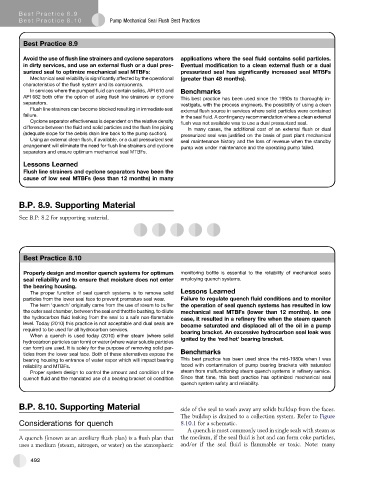Page 521 - Subyek Teknik Mesin - Forsthoffers Best Practice Handbook for Rotating Machinery by William E Forsthoffer
P. 521
Be st Practice 8 .9
Be st Practice 8 .10 Pump Mechanical Seal Flush Best Practices
Best Practice 8.9Practice 8.9
Best
Avoid the use of flush line strainers and cyclone separators applications where the seal fluid contains solid particles.
in dirty services, and use an external flush or a dual pres- Eventual modification to a clean external flush or a dual
surized seal to optimize mechanical seal MTBFs: pressurized seal has significantly increased seal MTBFs
Mechanical seal reliability is significantly affected by the operational (greater than 48 months).
characteristics of the flush system and its components.
In services where the pumped fluid can contain solids, API 610 and Benchmarks
API 682 both offer the option of using flush line strainers or cyclone
This best practice has been used since the 1990s to thoroughly in-
separators.
vestigate, with the process engineers, the possibility of using a clean
Flush line strainers can become blocked resulting in immediate seal
external flush source in services where solid particles were contained
failure.
in the seal fluid. A contingency recommendation where a clean external
Cyclone separator effectiveness is dependent on the relative density
flush was not available was to use a dual pressurized seal.
difference between the fluid and solid particles and the flush line piping
In many cases, the additional cost of an external flush or dual
(adequate slope for the debris drain line back to the pump suction).
pressurized seal was justified on the basis of past plant mechanical
Using an external clean flush, if available, or a dual pressurized seal seal maintenance history and the loss of revenue when the standby
arrangement will eliminate the need for flush line strainers and cyclone pump was under maintenance and the operating pump failed.
separators and ensure optimum mechanical seal MTBFs.
Lessons Learned
Flush line strainers and cyclone separators have been the
cause of low seal MTBFs (less than 12 months) in many
B.P. 8.9. Supporting Material
See B.P: 8.2 for supporting material.
Best
Best Practice 8.10Practice 8.10
Properly design and monitor quench systems for optimum monitoring bottle is essential to the reliability of mechanical seals
seal reliability and to ensure that moisture does not enter employing quench systems.
the bearing housing.
The proper function of seal quench systems is to remove solid Lessons Learned
particles from the lower seal face to prevent premature seal wear. Failure to regulate quench fluid conditions and to monitor
The term ‘quench’ originally came from the use of steam to buffer the operation of seal quench systems has resulted in low
the outer seal chamber, between the seal and throttle bushing, to dilute mechanical seal MTBFs (lower than 12 months). In one
the hydrocarbon fluid leaking from the seal to a safe non-flammable case, it resulted in a refinery fire when the steam quench
level. Today (2010) this practice is not acceptable and dual seals are became saturated and displaced all of the oil in a pump
required to be used for all hydrocarbon services. bearing bracket. An excessive hydrocarbon seal leak was
When a quench is used today (2010) either steam (where solid
hydrocarbon particles can form) or water (where water soluble particles ignited by the ‘red hot’ bearing bracket.
can form) are used. It is solely for the purpose of removing solid par-
ticles from the lower seal face. Both of these alternatives expose the Benchmarks
bearing housing to entrance of water vapor which will impact bearing This best practice has been used since the mid-1980s when I was
reliability and MTBFs. faced with contamination of pump bearing brackets with saturated
Proper system design to control the amount and condition of the steam from malfunctioning steam quench systems in refinery service.
quench fluid and the mandated use of a bearing bracket oil condition Since that time, this best practice has optimized mechanical seal
quench system safety and reliability.
B.P. 8.10. Supporting Material side of the seal to wash away any solids buildup from the faces.
The buildup is drained to a collection system. Refer to Figure
Considerations for quench 8.10.1 for a schematic.
A quench is most commonly used in single seals with steam as
A quench (known as an auxiliary flush plan) is a flush plan that the medium, if the seal fluid is hot and can form coke particles,
uses a medium (steam, nitrogen, or water) on the atmospheric and/or if the seal fluid is flammable or toxic. Note: many
492

